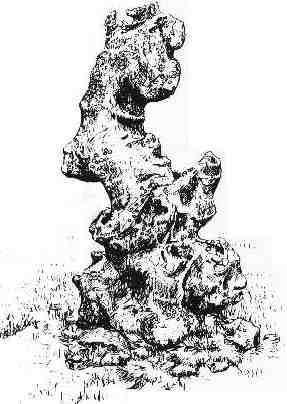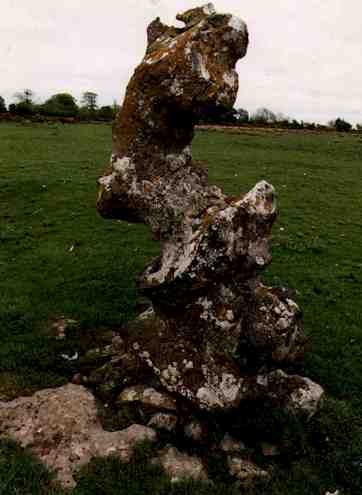
 |
Click on the one you want to learn more about:
| Ballinastack Dolmen: Cloc Diarmuid | Tobar na mBraher (Monk's Well) |
| Cillin Children's Burial Ground | The Bush of Cashel |
| Tober Patrick | Hedge School |
| Leacht na Máire Ní Bhrian. |
| Index | Boyounagh
- The Name |
Graveyard | History | Old Documents | Committee & Restoration |
Homepage | Rural
| Attractions | List
©Glenamaddy
"Diarmuid and Gráinne were contesting their strength at stone throwing from Mount Mary". Burial stones of this type are usually found in rich pasture land an dates to sometime like two thousand years before Christ. Surrounding the dolmen are marker stones that outline the burial of unbaptised children, the last in the early 1960’s. In a field adjacent to the main road nearby stand a pair of mature beech trees possibly an identity mark of another field monument - a large stone since removed. |
 |
Cloc Diarmuid bears a resemblence to Keelogues Wisdom stone:
 |
Cloc Diarmuid (left) Keelogues Wisdom Stone (right) |
 |
 |
![]()
This burial ground is situated in the townland of Boyounagh, four fields from Cashel Cross. It is horseshoe shaped. The mound is three foot high at the highest point. To the south Cashel Cross and shop are visible. The custom was that hen children died before they were baptised they were forgotten. No mass was ever said for these children. The custom was that no lid was ever nailed down, if it was the mother would not have another child.
![]()
To the East of the graveyard a stone is situated 10 yards from the boundary wall. It measures 4 feet and has a hollow centre. Popular belief has it that St. Patrick knelt there on his pilgrimage around Ireland. It was built by a humble friar named Patrick Mannion who lived nearby. This is also called the Friar's Well which is the most appropriate name for it. The function of this hollow stone was said to be a font; people used it to bless themselves with the water that lodged there before entering the monastery.
![]()
Several local people told us of an ash tree that marked the burial place of Mary O' Brien. She was an old woman whose body was been taken towards the graveyard and fell of the shoulders of the bearers here and it was the custom of the time (Famine time) to bury the corpse where it fell. When she fell this was considered more a threatening place. So a friend of hers planted a small sapling. This grew up and is now a large tree.
![]()
This was siad to be situated directly accross the road from the new graveyard in Boyounagh. This served as a water supply for the monks in the monastery. Local stories have it that rosaries were said at this well. Unfortunately no remains of this well are visible.
![]()
This was situated at Cashel Cross. It was a very large oak tree, measuring between 20 to 30 feet high. It was later replaced by a statue of our Lady. It had the reputation as been a fairy bush. Lights and "little folk" were meant to be seen underneath.
![]()
A hedge school was reported to be situated on the main Cashel - Lisheenaheltia road. It is in close proximity to Bligh's house today.